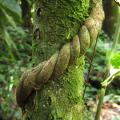
DMT-Nexus member
Posts: 804 Joined: 27-Feb-2016 Last visit: 20-Mar-2024
|
I've got a lot of samples lined up for testing, I'll add the results as I get through them. Acacia trigonophylla presents almost 0 alkaloids from root and trunk bark. 2mg recovered from 200g of working material. The nearest we ever come to knowing truth is when we are witness to paradox.
|
|
|
|
|

If you don't make mistakes, you are doing it wrong
Posts: 439 Joined: 23-Nov-2011 Last visit: 25-Nov-2023 Location: In a Concrete Hole, always in a concrete hole
|
Bit late to relpy to you I realise, but hey  Acaciasubliminata wrote:A funny example of the way she teases me.. I was doing some experimental extractions a couple of years back, and I found an acacia I couldn't identify. It had a weird smell. I had a strong feeling about it. I lovingly started a small twig/phyllode ext, but never finished it because life got in the way. A couple of years later, after my beautiful saplings had all eventually succumbed to my now transient lifestyle, I sent an acacia distribution map to a friend and realised that the odour of the mystery wattle was very reminiscent of raspberry jam! So close!! She has certainly taught this former atheist the meaning of faith!  Hello, my ears were ringing, you are talking about the Acacia Accuminata or Burkitti of western Australia, also known as the Raspberry Jam Tree. So..... encouragement encouragement. Think less of what the world is doing to you and more about what you are doing for it. Regards G One can never cross the ocean without the Courage to lose sight of the shore
|
|
|

DMT-Nexus member
Posts: 804 Joined: 27-Feb-2016 Last visit: 20-Mar-2024
|
200g of acacia cyclops harvested in winter presented ~20mg of alkaloids and oil. Material was branch bark that was triple pressure cooked, pulled with naptha while hot and evaporated. The nearest we ever come to knowing truth is when we are witness to paradox.
|
|
|
DMT-Nexus member
 
Posts: 4612 Joined: 17-Jan-2009 Last visit: 07-Mar-2024
|
Northerner wrote:
I've got a lot of samples lined up for testing, I'll add the results as I get through them.
Acacia trigonophylla presents almost 0 alkaloids from root and trunk bark. 2mg recovered from 200g of working material.
Northerner wrote:200g of acacia cyclops harvested in winter presented ~20mg of alkaloids and oil.
Material was branch bark that was triple pressure cooked, pulled with naptha while hot and evaporated. Thanks for doing these tests North, and keeping this thread going, good information to have, no doubt. 
|
|
|

DMT-Nexus member
Posts: 804 Joined: 27-Feb-2016 Last visit: 20-Mar-2024
|
It's my pleasure tatt  A. Celastrafolia presented no alkaloids from 200g branch bark harvested in spring, pressure cooked and naptha freeze precip. Smelled divine and was very oily. A. Acuminata thick phyllode branch bark from the same region harvested at the same time presented 1.2% alkaloids. Mostly DMT, very crystalline. A. Salinga presented 10mg goo from 300g of trunk bark, extracted as above. Suspected oil, trace alkaloids. The nearest we ever come to knowing truth is when we are witness to paradox.
|
|
|

DMT-Nexus member
Posts: 804 Joined: 27-Feb-2016 Last visit: 20-Mar-2024
|
I just want to say that all the samples I am testing were grown from seed specifically for timber on private property and are being felled anyway. I am not harvesting wild trees. I just needed to put that out there. There's so many ways to create more spice than one could ever smoke in just a few years, with just a little forethought. There is no reason to trash the environment. The nearest we ever come to knowing truth is when we are witness to paradox.
|
|
|

❤️🔥
 
Posts: 3648 Joined: 11-Mar-2017 Last visit: 10-Feb-2024 Location: 🌎
|
nen888 wrote:..for our Hawaiian Nexians, check this link.. Plants of Hawaii: acaciait lists the following Acacia species as recorded in hawaii: (the * = native, most are australian migrants) Acacia aneura - Mulga acacia Acacia aulacocarpa - Hickory wattle, brown salwood Acacia auriculiformis - Earpod wattle Acacia confusa - Formosa koa Acacia farnesiana - Klu Acacia koa - Koa * Acacia koaia - Koaia, dwarf koa * Acacia mangium - Mangium wattle Acacia mearnsii - Black wattle Acacia melanoxylon - Australian blackwood Acacia podalyriifolia - Queensland silver wattle Acacia retinodes - Water wattle Acacia sp. - Unknown acacia ..there are some very good tryptamine candidates there.. below are (all in Maui) A. retinodes, A. mearnsii, A. confusa, A. koaia leaf (with grazing Koa bugs Coleotichus blackburniae) & A. koaia tree... Thank you nen888 for all the acacia work. I'm trying to figure out what the tree in the images below is (found in Maui). I reviewed the images in the link above and this book of Hawaii trees, buy I'm not able to find a match (maybe I missed it). I was not able to find a seed pods on the tree. I found some nearby on the ground but can't be 100% sure they are from the same tree. Some of these trees had missing trunk bark, especially in one area slightly off the hiking trail. I don't quite understand this as I was under the impression that root bark is usually what is of interest to tree "poachers". Characteristics: Long skinny thorns allways in pairs with a branch coming out between them. phyllode, cream to white small flowers. The best match for ID from the phyllode size and branching structure, along with the flower appeareance is isimosa hostilis, but the thorns don't match: Hostilis has unpaired chubby curved thorns (example), while this tree has paired long straight thorns. Also, I don't think mimosa hostilis grows in this area. I'm in the area for a couple more days. Loveall attached the following image(s):  IMG_20190213_141749305.jpg (4,284kb) downloaded 304 time(s). IMG_20190213_141653932.jpg (4,462kb) downloaded 299 time(s). IMG_20190213_141639940.jpg (4,584kb) downloaded 299 time(s). IMG_20190213_141630613.jpg (4,909kb) downloaded 298 time(s). IMG_20190213_141616369.jpg (4,878kb) downloaded 297 time(s). IMG_20190213_134337504.jpg (6,914kb) downloaded 297 time(s).
|
|
|
member for the trees
  
Posts: 4003 Joined: 28-Jun-2011 Last visit: 07-Mar-2024
|
Hi and thanks Loveall.. i have spent a lot of time revising how to deal with information after witnessing a lot of acacia tree poaching in very sensitive habitats in Australia, and have rethought the whole book i have worked on as a result.. how to approach it.. ethics and environmental care seem to have completely escaped the minds of some who are supposedly interested in consciousness expanding plants..this has lead me to ponder that how these plants are written about in the current etheogenic world needs a new era..which is why i have been in semi retirement..
it seems now that Hawaii has unfortunately become afflicted with tree poachers.. in Australia some have taken trunk bark strips (of native acacias) which eventually kills the trees.. given their importance in the ecosystem and to a wide range of lifeforms, this is beyond criminal..
now while A. confusa is not native to Hawaii, this is still no way to treat the environment or a gift from nature..time again this thread has pointed out that twigs of acacias are equivalent to bark, and a much more sustainable part of the tree..but people should not be going after wild plants, unless we've learned nothing in the past few hundred years as a species..
it's the kind of use up resources without longterm thought thought that has plunged much of our planet into serious trouble..
regarding the tree you have attached pictures of, Loveall, pods would help, but it looks to me on a glance like Faidherbia albida (formerly Acacia albida), an interesting tree, which i did not know was naturalised in Hawaii but that's possible as it's been researched in agro-forestry a lot.. whether the poacher knew it's identity is an interesting question..
be well Loveall
hi to tatt, Gowpen (a true thread veteran), and thanks Northerner for the contribution
.
please respect trees people, it's not just in their interests but also ours
|
|
|

❤️🔥
 
Posts: 3648 Joined: 11-Mar-2017 Last visit: 10-Feb-2024 Location: 🌎
|
Many thanks nen888. There is no way I could have figured that possible ID on my own. I went back to the general area and looked for seed pods. I must have been there at the wrong time of the year because I could not find any on this kind of tree. I did find some on the ground, but of course I can't be 100% sure they come from the right tree. I'll plant some back home and see what happens. The pods are not as curved as the reference ones, but are a little curved (picture below). Cheers and thank you. It was sad to be in the spot where bark was being ripped off from these beautiful trees. They trees looked dry and unhealthy. Growing is the way to go, not harvesting from the wild or purchasing bark like you say. Loveall attached the following image(s):  IMG_20190216_100405201.jpg (7,817kb) downloaded 240 time(s).
|
|
|

DMT-Nexus member
Posts: 99 Joined: 04-Apr-2019 Last visit: 29-Feb-2024
|
acacian wrote:went for a bushwalk out at dangars falls yesterday and there is a species called acacia diphylla (or gorge wattle) which grows prevalently in the area.. its a subspecies of acacia blakei which has had positive results i think..
thinking i might give it a go How did you go at the dangar fall walk? Dorrigo is only 20min away from the godland i live in✌️
|
|
|

DMT-Nexus member
Posts: 353 Joined: 05-Jun-2019 Last visit: 23-Oct-2023 Location: nammyohorenghekyo
|
What an incredible thread. I am working on a collection of Acacias myself, but living in zone 7b makes for a hectic time every spring and fall, and a very crowded and precious few south facing windows during the winter months. So far I have a fairly impressive Madenii, several A. Simplex, and some Burkittii. I still want to add an Obtusifolia and a Confusa to my collection but I'm running out of space due to my recent interest in M. Specisosa cloning. I'm hoping to get some established before these crazy people ban it in NC in the desperate hopes of Granny Clausing them.. Anyone know how well Confusa and obtusifolia would respond to bonsai methods? Author of this Post assumes no Responsibility, nor makes any Guarantee of the Accuracy or Validity of material in this Post. Material Contained or referred to in this Post is presented for Entertainment Purposes Only. This Material IS Not Intended to be Inferred, or Interpreted as Information, Advice, News, Instruction, or Factual Information.
|
|
|

DMT-Nexus member

Posts: 337 Joined: 10-May-2014 Last visit: 28-Jan-2024
|
Does anyone have experience growing or processing Acacia Abyssinica?
I have access to a tree, wondering if it's worth getting some plant parts.
Definitely going to collect seeds.
|
|
|

DMT-Nexus member

Posts: 337 Joined: 10-May-2014 Last visit: 28-Jan-2024
|
Was browsing around the internet and came across some articles that said Acacias release tannins when antelope and giraffes eat their foliage. The trees send signals to other trees so the animals won't continue eating. What came to mind is if animal activity on Acacias can interfere with alkaloids? (1)"Van Hoven made his discovery when asked to investigate the sudden death of some 3000 South African antelope, called kudu, on game ranches in the Transvaal. He noticed that giraffe, roaming freely, browsed only on one acacia tree in ten, avoiding those trees which were downwind. Kudu, which are fenced in on the game ranches, have little other than acacia leaves to eat during the winter months. So the antelope continue to browse until the tannin from the leaves sets off a lethal metabolic chain reaction in their bodies." (2)"A zoologist from South Africa, Wouter Van Hoven found that acacia trees also have another chemical defense system, whereby they release a chemical called ethylene. This chemical can travel up to 45m, ‘warning’ other acacias in the vicinity. Within 15 minutes all the neighbouring trees increase the tannin levels in their leaves, making the area pretty unappetizing to tree-browsing animals. In order to ensure enough food, giraffes tend to eat downwind from trees, in the hope that the trees do not alarm each other. They also usually browse only for a short time before moving on to the next tree." Acacias that might do this though only 2 were specifically mentioned in articles below: Acacia Galpinii, A. Tortillis, A. Drepanolobium, A. Xanthophloea, A. Sieberiana(woodii) (1)"Antelopes" https://www.newscientist...he-acacias-alarm-system/"Giraffes" https://www.africansafar...uniquely-african-tussle/"Shaman-Australis: "Acacia Trees Can Kill" http://www.shaman-austra...e-acacia-trees-can-kill/"Acacia tree kills antelope" https://www.jstor.org/st...1#page_scan_tab_contents"Acacia release ethylene gas as trigger warning" https://asknature.org/st...l-presence-of-predators/"Acacia alarm system" https://www.southerndest...-acacia-tree-phenomenon/(2) Mentions Acacia Tortilis and Acacia Drepanolobium https://www.tanzania-exp...clever-species-of-trees/(The picture is one I took of a 15 foot tall Acacia Xanthophloea at a park near me) Chimp Z attached the following image(s):  7D589CEB-02C3-4A36-9D28-714CD4E73F0B.jpg (791kb) downloaded 158 time(s).
|
|
|

DMT-Nexus member

Posts: 337 Joined: 10-May-2014 Last visit: 28-Jan-2024
|
Palo Blanco-Mariosousa willardiana(formerly Acacia Willardiana) grows near me. I have been interested in smoking its phyllodes and eventually making an extract from the tree. Upon researching Acacia Willardiana I came across phycotoxins which are said to be in the seeds; "Phycotoxins are potent organic compounds produced by dinoflagellates, other flagellated phytoplankton, and cyanobacteria that inhabit marine, brackish, or freshwater bodies or soils." https://www.sciencedirec...ical-science/phycotoxinsIn the article they mention "willardine" or 5-flourowillardine. [wiki] "5-Fluorowillardiine is a selective agonist for the AMPA receptor,[1][2][3] with only limited effects at the kainate receptor.[4] It is an excitotoxic neurotoxin when used in vivo and so is rarely used in intact animals, but it is widely used to selectively stimulate AMPA receptors in vitro.[5][6][7] The name is unusual as it has two successive i's. This is not a typo. 5-Fluorowillardiine exists as two distinct isomers: (2R) or D (2S) or L " Is this something to worry about in the rest of the plant? Can stuff like this be boiled out? (Attached are pictures I took of an Acacia Willardiana I met/There's more nearby) https://en.wikipedia.org/wiki/5-Fluorowillardiinehttps://www.ncbi.nlm.nih...pmc/articles/PMC1572873/https://www.ncbi.nlm.nih...pmc/articles/PMC1908955/http://www.jneurosci.org...jneuro/12/2/595.full.pdfhttp://www.jneurosci.org...jneuro/12/2/595.full.pdfChimp Z attached the following image(s):  A99943C0-5FFF-4EE7-A108-8E2CF9C9AD79 (1).jpg (500kb) downloaded 149 time(s). IMG_0839.jpg (1,719kb) downloaded 147 time(s).
|
|
|
member for the trees
  
Posts: 4003 Joined: 28-Jun-2011 Last visit: 07-Mar-2024
|
..firstly, that's great to hear, twitchy, about those species growing in your area, thanks ..there have been a few cases of A. confusa bonsai, and some acacias in the wild, growing in very rocky with little soil conditions, are natural bonsais or 'semi-bonsais'..specimens which are only a couple of feet tall can be actually quite old in such conditions as their roots never get through the narrow soil layer above the rock.. second up... Chimp Z...hi, and that's great information...in the true spirit of the thread..thanks  ! nice photos too.. i really enjoy hearing about giraffe and other herbivore dynamics with acacias...and root signalling between acacias..it really starts to show how involved in the whole environment the trees are, which is part of why they are so culturally important in history... regarding Acacia (Mariosousa) willardiana, it is a species i've always thought interesting...but i'd urge extreme caution this stage.. now while it's more often a case that compounds in acacia seeds and pods are not the same as in phyllodes, leaves or bark, we don't in this case know for sure...we don't have the phytochemical data on this species, and we have very little toxicological data on 5-flourowillardine..no LD50, or clinical trials, or ethnobotanical medicinal info (which might have once existed)..it's not at all clear just how toxic it is..an AMPA agonist may have some interesting future in neuroplasticity research, and many aspects of brain function, but could also lead to seizures or be extremely toxic...it is interesting to note, though, that another AMPA agonist (a weak agonist) is Ibotenic acid, found in Amanita muscaria mushrooms.. i don't know that 5-flourowillardine would degrade on pyrolisis or acidolysis (as do cyanogenic glycosides)..i would urge you to get the plant material tested by GCMS, which is now increasingly accessible for free or low cost through the nexus, and other places, before any bioassay..this is one recent positive advancement of the past few years in such underground research..if you can do this please let us know, as the 'white stick' is indeed an intriguing species, as are a number of the lesser known north and central american acacias (mariosousas, vachellias etc..i still don't accept the renaming, due to the historio-cultural significance of 'acacia' ) keep up the interesting research Chimp Z
|
|
|
member for the trees
  
Posts: 4003 Joined: 28-Jun-2011 Last visit: 07-Mar-2024
|
..while i’m here..i’ve been sitting on the following info for a couple of months, but it’s probably about time to put it out there..with regards to high tryptamine content Australian acacias.. in 2005 Dr Karl Kruszelnicki stated, on ABC national radio, that Acacia colei contained 1.8-2 % DMT in the bark..then one or two very sketchy underground net reports said they had found nothing and the species fell out of notoriety..recently a more reliable source has confirmed this content finding, also confirmed by nexian and thread contributor Seldom (thanks Seldom) ...there was no reason to doubt as reliable a source as Dr Kruszelnicki, and i think this highlights 1) the problem with assessing whether underground net reports have correctly identified the source plant species, and 2) that as a result of simplistic methodology or seasonal variation in other components in a plant, it can be the case that an extraction on an alkaloid containing acacia can fail to extract any or most of the alkaloids..this has been discussed in the thread, and noted by a few researchers..some low percentage findings of alkaloids in phyllodes are in this category, particularly due to material not being dry..and of course general seasonal variation in content can occur..it needs to also be stressed, as always, that when we see a reference to an acacia species bark content, this is in fact the same content in the small twigs and branches of the plant..the trunk and root bark should never be touched or damaged as this will seriously stress and kill the tree Acacia colei is very common across northern areas of Australia, in Western Australia, the Northern Territory and western Queensland, and is easily grown..it has two subspecies: var. colei (more common) and var. ileocarpa.. A. colei is a hexaploid believed to have evolved as an allopolyploid from A. neurocarpa (diploid) and A. cowleana (tetraploid), showing the many interesting interelations that can occur between acacias, and their complex genetics.. this information on it’s confirmed tryptamine content is put forward in the interests of less common and under threat species, as A. colei is both common, and easily cultivatable.. please respect trees and plants in the wild, as this is in everyone’s and the environment’s interests.. as this thread documents, there has already been serious damage to acacia trees and habitats by the ignorant, greedy and selfishly destructive.. may the wild trees live quietly in peace.. . A. colei var. colei below:nen888 attached the following image(s):  acacia_colei.jpg (442kb) downloaded 136 time(s). Acacia colei var colei.png (429kb) downloaded 10 time(s).
|
|
|
DMT-Nexus member
Posts: 183 Joined: 10-Jun-2017 Last visit: 13-Jul-2020
|
Wow! That's big news about colei. Thanks nen.
Do we know if Colei will tolerate conditions in the southern states of Australia?
Do we know what the phyllode content is like?
I always dismissed dr Karl's comments as I'll informed......
|
|
|
member for the trees
  
Posts: 4003 Joined: 28-Jun-2011 Last visit: 07-Mar-2024
|
hi leratiomyces..phyllode content of A. colei was reported at 0.2-06% alkaloids.. as far as cultivation in different regions goes, it is commonly grown in warmer to tropical regions, but in it's southern desert natural range probably doesn't experience temperatures below about 7°C.. for Australian species with tryptamine/alkaloid content to grow in colder climates (i.e. below 7° down to about minus 3), candidates include A. floribunda, A. phlebophylla (rare and harder to obtain seed), A. implexa, A mucronata, and the still somewhat mysterious A. retinodes (which is grown in Germany)..A retinodes has as yet un-retested claims of dmt/nmt, but also nicotine, which needs to be looked at, an would make oral ingestion dangerous..the very closely related A. provincialis (which is believed to be a hybrid of A. retinodes and A. cyanophylla (saligna), or in fact A. retiondes var retinodes) may contain a completely unknown psychoactive alkaloid (based on a report a few years ago from a speciemen naturalised in Bolivia)..it's also worth noting that A. baileyana (with some reports of alternating beta-carbolie and tryptamine content) grows in the UK.. ps, Chimp Z..i personally have not grown A. (Vachellia) abyssinica, but this would be a really interesting one to cultivate..good luck with that..another interesting one.. . below, A. abyssinica nen888 attached the following image(s):  Acacia-abyssinica.jpg (137kb) downloaded 114 time(s).
|
|
|
member for the trees
  
Posts: 4003 Joined: 28-Jun-2011 Last visit: 07-Mar-2024
|
..i’ll make a few notes, now that this thread has reached an unprecedented number of views..(a lot more people read than write)..keep the good information coming in..acacias are important to the future of humanity, and environments, for a few reasons..
there are all sorts of things going on out there in the wider acacia world since this thread..african and middle eastern species like A. nilotica are being utilised as entheogens by people; some american specie seem to be getting some overdue experimental attention now; and shadowy and mysterious ‘research’ institutes (with equally shadowy funding) are doing experiments with acacia ‘elixirs’ and dmt ‘tests’ with acacias..hmm
the thread was originally a humble attempt to get people to stop abusing and misusing a few very under threat and traumatised in the wild species, by offering more common alternatives; to encourage growing and sustainable approaches; and to bring awareness that the acacia is a unique and indeed sacred family of plant medicines that should not be treated at as ‘dmt’ sources, or casually exchanged for ‘ayahuasca’ (a completely different pair of plants, including in character and content, and tradition)..much of the disrespect and abuse of acacias came about after the rise in popularity of ‘changa’, which served some as both a means of commercial distribution, and also completely obscures the actual plant which is giving most of the insight - often in aus an acacia
..some good things have come out of the thread, especially a huge increase in the growing of different species, and their appreciation in general..however there are still some not great things that have happened..there has been in increase in the abuse of A. acuminata in the wild, and also some people trying to give other people this tree as ‘ayahuasca’, with very little experience, and certainly very little knowledge of the parameters of acacia, especially toxicologically, as well as spiritually..
..there are some key major points i’d like to make about acacias -
firstly, that, being very diverse in complex chemistry (beyond alkaloids), they are highly important in medicinal uses in general, both traditionally and in modern research (there’s much info in the thread)..there is an inherent danger that the constant attention given to them for simply dmt will bring unwanted negative attention to their ongoing medicinal use and research (for a wide range of physical conditions), and i encourage awareness of this diversity within acacias..
it can also be overlooked (including by regulating authorities) that dmt and other tryptamine may and probably do have simply physical therapeutic use, with the entheogenic effects being a ‘side-effect’ of higher dose..there was recent research suggesting dmt as an example may physically be an immune system regulator..
secondly, in a number of cultures around the world acacias are a highly sacred and culturally important tree..in this modern age we increasingly lose any meaning or understanding of what the word sacred means..but the metaphor i sometimes use in talks is how would you treat your grandmother, or friends, or want them to be treated..
also, i have chosen in the thread to ignore the re-naming a few years back of African, Asian and American species (to Vachellia, Senegalia etc) for the same reason a number of key botanists objected to this at the very international meeting where this was voted for..the cultural and historic importance of the name acacia, especially in Africa and the middle-east..also, ‘acacia’ means ‘thorns’, and the species with thorns are primarily here, not in Australia..
.
i had mostly retired from posting much here, partly out of meditating on the consequences of information (as someone once said: ‘a little knowledge is dangerous’ ) ..and also to finish writing a book of the acacia..much of the delay has been in deciding what to say and what not to..but also it was time to pull back from the net a bit as really, for all the information in here, the thread and ‘nen888’ are still a mask..a mask for deeper knowledge, experience and understanding of the acacia tree..
the book can go a little bit deeper into this..though some things will always be oral tradition
for so many reasons we are fortunate to have the acacia tree in the world, an so many other forms of life rely on them other than humans..as said a while back in the thread they are a ‘total tree’ - medicine, food, building, soil and environmental restoration, and an aesthetic as well as sacred resonance..
thank you to all who have shared here, and grown and looked after and honoured the trees..
and gratitude and respect, of lifetimes, to the trees, for all that they do!!
.
please be kind to trees...
.
|
|
|

DMT-Nexus member
Posts: 1111 Joined: 18-Feb-2017 Last visit: 02-Apr-2024
|
nen888 wrote:for Australian species with tryptamine/alkaloid content to grow in colder climates (i.e. below 7° down to about minus 3), candidates include A. floribunda For what it's worth, my A. floribunda (the low-branching form) has taken -6C without batting an eyelid and is very vigorous. Also the standard form of A. baileyana seems at least as hardy, but the popular (for its ornamental value) 'Purpurea' variety is tender and I've lost two to winters.
|